Are carpenter bees buzzing around your Monmouth County property? Does the thought of getting stung have you rethinking hosting those backyard gatherings? Get up to speed about these bees and how pest control can help.
Nope, it’s not a hive you need to worry about. Carpenter bees bring an entirely different problem to the table. Alliance Pest Solutions will be happy to explain the dangers of these bees to you.
Carpenter bees are often categorized into two genera- Xylocopa (large carpenter bees) and Ceratina (small carpenter bees). These two genera do not have the same size, and this is probably the most obvious characteristic used in differentiating between both of them. While Xylocopa is around 12-25 mm long, Ceratina is less than 8 mm long.
Carpenter bees are a large family of bees with about 500 different subspecies, and about 31 sub genera. Their name comes from their tendency to excavate tunnels into wood for nesting purposes. They are most commonly noticed in late springtime or the beginning of summer.
Have you ever seen little piles of sawdust under wood that has perfectly circular holes in it? If so, you’ve seen the masterwork of a carpenter bee. No one likes bees. They sting, fly, and buzz and although they are beneficial to the environment, they can be harmful and a nuisance to humans.
Carpenter bees are the larger bee in the bee family and they can be found all over the world. There is approximately 500 species of the carpenter bee.

Carpenter bees are large bees that can be found throughout the world. It is estimated there are more than 500 species of carpenter bees. These pests get their name because…


